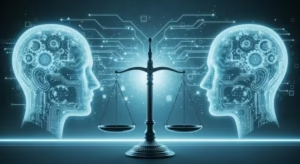AI and Ethics: Can We Program Morality?

The blog post AI and Ethics: Can We Program Morality? delves into the complex relationship between AI ethics and technology, exploring whether morality can be effectively programmed into artificial intelligence. It begins by defining AI ethics and highlights the intersection where technology meets moral considerations. The article addresses the significance of bias in AI systems, outlining the challenges faced and potential solutions for mitigating these issues. Additionally, it discusses the importance of implementing AI governance frameworks to ensure ethical practices in development and deployment. Finally, the post provides actionable insights for developers and organizations to promote responsible AI development, emphasizing the need for ongoing dialogue and ethical standards in the rapidly evolving field of artificial intelligence.
Understanding AI Ethics: The Intersection of Technology and Morality

The rapid advancement of artificial intelligence (AI) technologies has sparked a critical dialogue on AI ethics and the moral frameworks that govern their development and implementation. At the core of this discourse is a profound question: can we program morality into machines? As algorithms increasingly influence decision-making in various sectors, from healthcare to criminal justice, understanding the ethical implications is crucial. Establishing guidelines that steer the creation of ethical algorithms ensures that AI systems align with societal values and human rights.
Key Considerations in AI Ethics
- Transparency in AI decision-making processes
- Accountability for AI-generated outcomes
- Ensuring fairness and eliminating bias
- Promoting user privacy and data protection
- Incorporating societal values into AI design
- Facilitating public understanding of AI technologies
As we strive to develop ethical algorithms, it becomes imperative to include stakeholders from diverse backgrounds in the conversation, such as ethicists, software engineers, legal experts, and community representatives. This multidisciplinary approach not only enriches the understanding of AI ethics but also fosters a sense of shared responsibility. A collaborative framework can bring about a holistic view of the ethical landscape, ensuring that technology serves the greater good. By integrating diverse perspectives, we can better anticipate the potential consequences of AI deployment.
Ultimately, the challenge of instilling morality in AI systems lies in the tension between technological innovation and ethical accountability. As we further explore the complexities of AI ethics, it is pivotal to strike a balance that fosters innovation while upholding the fundamental principles of humanity. As this field evolves, continuous dialogue and adaptive regulatory measures will be essential in guiding AI development towards an ethical future that benefits all members of society.
Exploring Bias in AI: Challenges and Solutions

Bias in AI presents significant challenges that can undermine the credibility of systems designed to promote fairness and equality. The inherent flaws in data collection and algorithmic design can lead to outcomes that discriminate against certain groups or individuals. Understanding how to identify and mitigate these biases is essential for developing responsible AI. The urgency for ethical considerations in AI is growing as its applications become more widespread across various sectors.
| Type of Bias | Description | Example |
|---|---|---|
| Data Bias | Occurs when the dataset used to train models is not representative of the intended population. | Facial recognition technology misidentifying individuals from minority groups. |
| Algorithmic Bias | Arises from the algorithms that process data in ways that reinforce stereotypes. | Loan approval algorithms favoring specific demographics. |
| Human Bias | Involves biases introduced by developers in code and design decisions. | Choices made by developers that reflect personal biases. |
Identifying Bias in AI Models is the first step toward ensuring ethical compliance in artificial intelligence. By thoroughly assessing datasets and algorithms, practitioners can uncover hidden biases that may lead to unfair or harmful outcomes. Awareness of these biases is not just a matter of ethical standards but a necessity for the effective functioning of AI systems. Inclusive datasets and transparent practices are crucial for fostering trust and reliability in AI ethics.
Identifying Bias in AI Models
Various methods exist for identifying bias in AI models, ranging from statistical tests to human evaluations. These methods help pinpoint discrepancies and alert developers to potential issues before implementation. Engaging diverse teams to review AI systems can also offer perspectives that help to uncover less obvious biases, ensuring a more comprehensive understanding of ethical implications involved.
Strategies for Reducing Bias
To tackle bias effectively, organizations can adopt a series of strategies aimed at refining their AI systems. Incorporating guidelines for ethical AI and practices can significantly reduce the risk of biased outcomes. Additionally, continuous monitoring and iteration of AI models allow organizations to make adjustments based on real-world feedback, maintaining ethical standards throughout the lifecycle of the AI solution.
Steps to Address Bias in AI
- Conduct a thorough audit of data used for training AI models.
- Implement diversity in development teams to leverage varied perspectives.
- Use statistical techniques to uncover and correct biases.
- Engage with stakeholders to gain insights into community concerns.
- Deploy monitoring tools to assess bias in live systems.
- Maintain transparency in algorithmic design and decision-making processes.
- Foster a culture of ethical awareness in AI development.
Identifying and reducing bias in AI is a critical aspect of ensuring responsible AI that aligns with ethical standards. The integration of comprehensive strategies and practices not only improves the algorithms but also builds public trust and acceptance of AI technologies. By prioritizing these efforts, we can aspire to a future where artificial intelligence operates fairly and equitably for all.
Implementing AI Governance for Ethical Practices

The rapid evolution of artificial intelligence (AI) has brought forth significant discussions surrounding AI ethics and the necessity for strong AI governance mechanisms. Organizations are increasingly recognizing that ethical algorithms must reflect societal values and expectations, thereby fostering trust in AI systems. By developing robust frameworks for governance, companies can not only mitigate risks but also enhance accountability and transparency in AI deployment.
Central to effective AI governance is the establishment of a comprehensive framework that guides the ethical development and implementation of AI systems. This framework should encompass various dimensions, including data privacy, algorithmic bias, and user consent. By incorporating these aspects, organizations can ensure that their AI solutions adhere to ethical standards while minimizing the impact of adverse consequences on individuals and communities. The table below illustrates the key elements that contribute to a structured AI governance approach:
| Key Elements | Description | Significance |
|---|---|---|
| Transparency | Clear visibility into AI processes and algorithms | Builds trust among users |
| Accountability | Establishing clear responsibilities for AI outcomes | Ensures ethical practices |
| Inclusivity | Engaging diverse stakeholders in AI development | Reduces bias and promotes fairness |
| Robustness | Ensuring systems are resilient to failures | Enhances reliability and safety |
In addition to the structural components, organizations must focus on the essential components of AI governance to create a sustainable ecosystem. These components not only ensure that AI systems are ethical but are also pivotal in fostering innovation. The following list outlines critical components that every organization should consider:
Essential Components of AI Governance
- Compliance with legal standards
- Ethical guidelines for AI development
- Regular audits and assessments of AI systems
- Stakeholder engagement and feedback mechanisms
- Development of ethical algorithms
- Training programs for staff on AI ethics
Establishing an effective AI governance framework is not merely a regulatory requirement; it is a proactive approach to integrating ethical considerations into AI development. By adopting such measures, organizations can navigate the complexities of AI ethics and promote responsible practices that align with societal values.
Frameworks for Effective AI Governance
To achieve meaningful AI governance, it is crucial to adopt established frameworks that guide organizations in integrating ethical standards within their AI lifecycle. These frameworks can encompass methodologies such as directive principles, ethical codes, and industry benchmarks, all designed to facilitate consistent and fair AI practices. Adopting such frameworks can significantly contribute to the creation of ethical algorithms that are vital for ensuring that AI systems serve the broader good while minimizing risks to individuals and society.
Actionable Insights for Responsible AI Development

As the field of AI continues to evolve, it becomes increasingly essential to prioritize responsible AI development. This entails integrating ethical considerations into the design and deployment of AI systems. By fostering dialogue around AI ethics, developers can mitigate risks related to bias, privacy, and accountability. A broad understanding of the implications of AI technologies helps create systems that not only perform effectively but also respect societal values and human rights.
Key Takeaways for Developers
- Incorporate ethical frameworks during the design phase of AI systems.
- Regularly audit algorithms for bias and ensure diversity in training data.
- Engage with stakeholders, including ethicists and community representatives, for feedback.
- Implement transparency measures that allow users to understand AI decision-making.
- Focus on accountability by establishing clear guidelines for AI usage and consequences for misuse.
- Stay informed about evolving regulations and standards related to AI ethics.
- Encourage interdisciplinary collaboration to enrich AI development with diverse perspectives.
Ultimately, the path to responsible AI development is paved with continuous learning and adaptation. Developers must remain vigilant against pitfalls in emerging technologies, balancing innovation with ethical responsibility. By embedding these principles into the AI lifecycle, they can contribute to a future where technology not only enhances efficiency but also reinforces trust and ethical standards in society.
For similar articles, please visit: AI and Ethics
Homepage / humanaifuture.com




